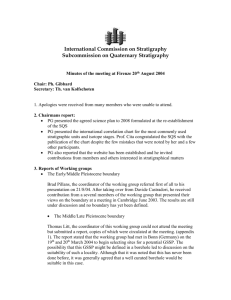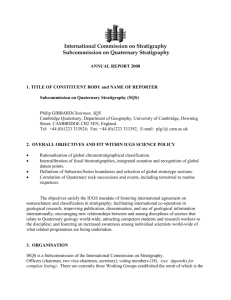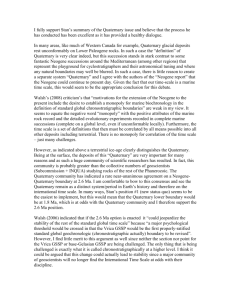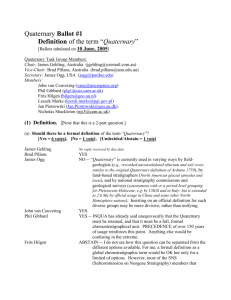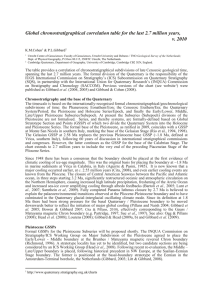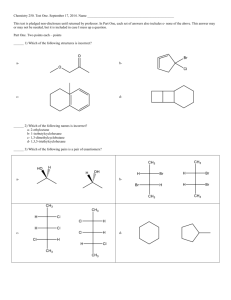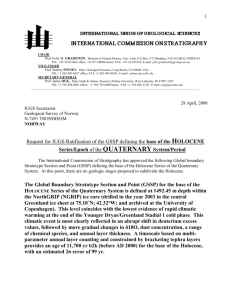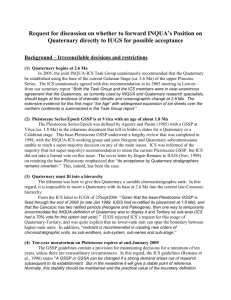2011 - Subcommission on Quaternary Stratigraphy
advertisement
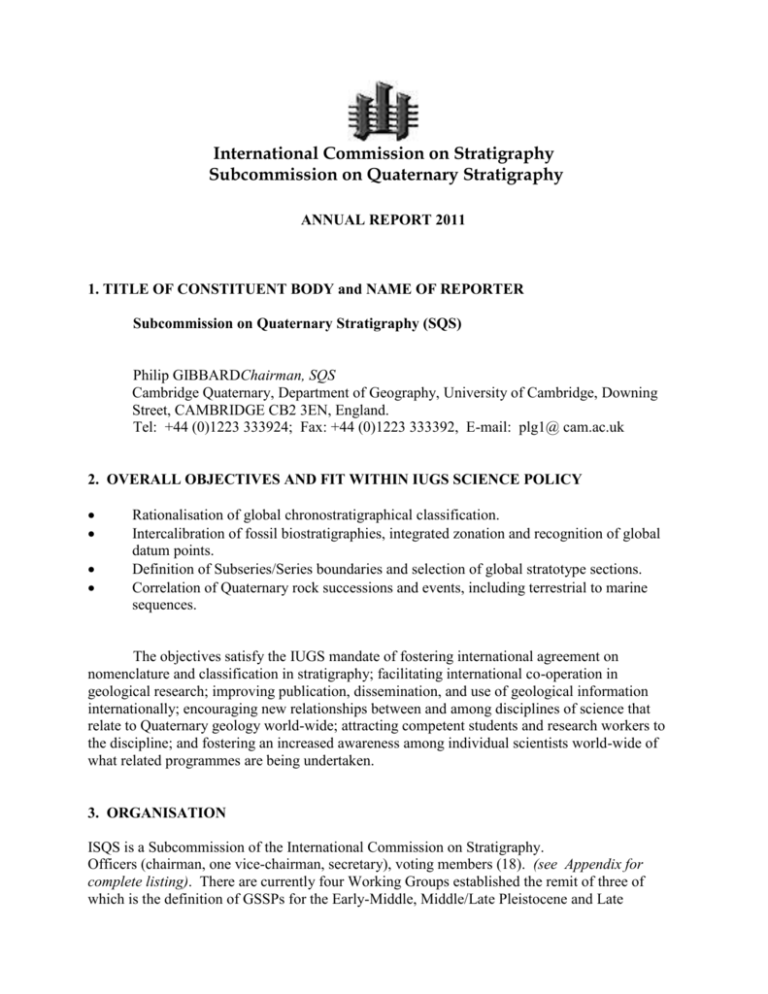
International Commission on Stratigraphy Subcommission on Quaternary Stratigraphy ANNUAL REPORT 2011 1. TITLE OF CONSTITUENT BODY and NAME OF REPORTER Subcommission on Quaternary Stratigraphy (SQS) Philip GIBBARDChairman, SQS Cambridge Quaternary, Department of Geography, University of Cambridge, Downing Street, CAMBRIDGE CB2 3EN, England. Tel: +44 (0)1223 333924; Fax: +44 (0)1223 333392, E-mail: plg1@ cam.ac.uk 2. OVERALL OBJECTIVES AND FIT WITHIN IUGS SCIENCE POLICY Rationalisation of global chronostratigraphical classification. Intercalibration of fossil biostratigraphies, integrated zonation and recognition of global datum points. Definition of Subseries/Series boundaries and selection of global stratotype sections. Correlation of Quaternary rock successions and events, including terrestrial to marine sequences. The objectives satisfy the IUGS mandate of fostering international agreement on nomenclature and classification in stratigraphy; facilitating international co-operation in geological research; improving publication, dissemination, and use of geological information internationally; encouraging new relationships between and among disciplines of science that relate to Quaternary geology world-wide; attracting competent students and research workers to the discipline; and fostering an increased awareness among individual scientists world-wide of what related programmes are being undertaken. 3. ORGANISATION ISQS is a Subcommission of the International Commission on Stratigraphy. Officers (chairman, one vice-chairman, secretary), voting members (18). (see Appendix for complete listing). There are currently four Working Groups established the remit of three of which is the definition of GSSPs for the Early-Middle, Middle/Late Pleistocene and Late Pleistocene/Holocene boundaries and the fourth is to investigate the validity and applicability of the term Anthropocene. A fifth working group is currently planned that will examine the utility of formal definition of short-time divisions. These individuals represent a broad spectrum of specialised stratigraphical disciplines from throughout the World. Publication of information is by website. 3a. Nominated Officers for 2010-2012: Chairman: Professor Philip Gibbard Godwin Institute of Quaternary Research Department of Geography, University of Cambridge Downing Street, Cambridge CB2 3EN, England E-mail: plg1@cus.cam.ac.uk Vice-Chair: Professor Jerry McManus Wood's Hole Oceanographic Institute Wood's Hole, MA, USA E-mail: jmcmanus@ldeo.columbia.edu Secretary: Professor Thijs van Kolfschoten Faculty of Archaeology, Leiden University Reuvenplaats 4, 2300 RA Leiden, The Netherlands E-mail: T.van.Kolfschoten@rulpre.leidenuniv.nl 4. EXTENT OF NATIONAL/REGIONAL/GLOBAL SUPPORT FROM SOURCES OTHER THAN IUGS Support of the Chairman's University (University of Cambridge), and the International Association of Quaternary Research (INQUA). Also support from national stratigraphical bodies, including in particular the Geological Society Stratigraphical Commission (GB). 5. CHIEF ACCOMPLISHMENTS IN 2011 Two GSSP Working Groups (Middle Pleistocene and Late Pleistocene) continue to have fully functioning formal working groups (see below for membership lists). The Anthropocene working group, established in 2009, continues to work very actively this year. Following last year’s establishment of a small group led by Professor Maria Bianca Cita to compile a proposal for establishment of a basal GSSP for the Calabrian Stage, the proposal was successfully agreed by ICS voting members and was submitted to IUGS for ratification in November 2011. It was decided to wait before developing fledgling working groups into fully functioning organisations until the principal GSSP goals had been settled. The Working Group on the Lower/Middle Pleistocene Subseries boundary currently comprises: Luca Capraro (Italy), Neri Ciaranfi (Italy), Craig Feibel (USA), Martin Head (Canada, Co-Chair), Hisao Kumai (Japan), Luc Lourens (The Netherlands), Lui Jiaqi (China), Anastasia Markova (Russia), Tom Meijer (The Netherlands), Muneki Mitamura (Japan), Brad Pillans (Australia, CoChair), Cesare Ravazzi (Italy), Charles Turner (UK), Thijs Van Kolfschoten (The Netherlands). Three sections remain under consideration, the Montalbano Jonico section in the Province of Matera, Southern Italy (proponent, Neri Ciaranfi), the Valle di Manche section in the Crotone Basin, Southern Italy (proponent, Luca Capraro), and the Chiba section in Japan (proponent, Hisao Kumai). Unfortunately, each section has its problems. The Montalbano Jonico section is in many ways ideal but efforts to obtain a magnetostratigraphy have not been successful owing to diagenetic overprinting (Sagnotti et al., 2010). This is a crucial problem because it has long been accepted that the Matuyama–Brunhes boundary should serve as the principal guide to the Early–Middle Pleistocene boundary. Nonetheless, progress is being made on this section. For example 40 Ar/39Ar dating shows an age of 805.42 ka ± 12% for the volcaniclastic V3 layer of Montalbano, which is close to that of the Matuyama–Brunhes boundary. Plans are nonetheless in progress to propose the Montalbano Jonico section, even without magnetostratigraphy, on the basis of many other correlatable signals. The Valle di Manche section has magnetostratigraphy and the Matuyama–Brunhes boundary is clearly demarcated. Detailed bio- and isotope stratigraphies are available for this section, although there seem to be problems with the interpretation of the pollen record. Luca Capraro and colleagues are willing to submit a formal proposal on this section at relatively short notice. The Pitagora Ash, which lies close to the Matuyama–Brunhes boundary in the Valle di Manche section, is not apparently recognised definitively in the Montalbano Jonico section. The Chiba section in Japan has a recorded magnetostratigraphy, with the Matuyama–Brunhes boundary clearly shown, and there are many additional published studies (mostly in Japanese). However, no synthesis in English is available to evaluate the section. A one-day international symposium, organised by Prof. Hisao Kumai, was held in Ichihara City, Chiba Prefecture, Japan on 15 January 2011 followed by a field trip to the section. Brad Pillans and Martin Head gave invited presentations at the symposium, and evaluated the section with Japanese colleagues the following day. The potential type section is part of a sequence of outcrops exposed along deeply incised valleys of the Yoro River system. Sedimentation is continuous from the Gelasian to the Middle Pleistocene and sedimentation rates are very high, the Calabrian alone being more than 1 km thick. Plans are underway to publish a synthesis paper in English on the Chiba section. The Working Group on the Middle/Upper Pleistocene Subseries boundary has continued throughout the year under the chairmanship of Professor T. Litt (Bonn). The aim was to find an agreement about the selection of a geological section for a potential boundary stratotype (GSSP). The full formal GSSP proposal defining the Middle/Upper (Late) Pleistocene boundary was prepared in 2008 at the Amsterdam Terminal (the Eemian Stage parastratotype). This boundary should constitute the Global Stratotype Section and Point (GSSP) for the base of the Upper (Late) Pleistocene Subseries (Quaternary System/Period). The International Commission of Stratigraphy has approved this GSSP proposal. The voting by the Quaternary Subcommission was 100% in favour (18 voting). The votes received from the ICS voting membership were 10 in favour (71%), and 4 against. The request for IUGS ratification of this GSSP definition was considered by the IUGS Executive Committee in September 2008, however, the IUGS EC did not ratify this proposal as presented by the SQS/ICS, mainly based on procedural matters, protocol and principle. Unfortunately work on this boundary has not progressed and is unlikely to be restarted until the situation concerning the inclusion of the ‘Tarentian Stage’ as a ‘standard stage’ or not is clarified. The current chair, Professor Litt, is strongly opposed to this development and therefore progress must await further developments. The Working Group on the Pleistocene-Holocene boundary, chaired by Professor M.Walker (Lampeter)was completed in 2008. The working group has ceased activity. However, a joint Working Group of INTIMATE and the SQS is considering a formal subdivison of the Holocene Series/Epoch. Although previous attempts to subdivide the Holocene have proved inconclusive, recent developments in Quaternary stratigraphy, notably the definition of the PleistoceneHolocene boundary and the emergence of formal subdivisions of the Pleistocene Series/Epoch, mean that it may be timely to revisit this matter. The Quaternary literature reveals a widespread informal usage of a tripartite division of the Holocene (‘early’, ‘middle’ or ‘mid’, and ‘late’), and the Working Group has come to the view that this de facto subdivision should now be formalised to ensure consistency in stratigraphic terminology. The WG is proposing an Early-Middle Holocene Boundary at 8.2 ka BP and a Middle-Late Holocene Boundary at 4.2 ka BP, each of which is linked to a Global Stratotype Section and Point (GSSP), and is preparing a ‘position paper’ setting out the details of the proposal for publication in Journal of Quaternary Science. Should this find a broad measure of support from the Quaternary community, a submission will be made to the IUGS, via the SQS and the ICS, for formal ratification of a subdivision of the Holocene Series/Epoch. The Anthropocene Working Group, chaired by Dr J. Zalasiewicz (Leicester). This year the group has published a thematic issue of the Philosophical Transactions of the Royal Society of London on the Anthropocene, and is preparing a follow-up volume, specifically dealing with stratigraphical aspects, to be submitted as a Special Publication of the Geological Society of London. A successful meeting was held in at the Geological Society of London (Burlington House) in May 2011. There has been a good deal of discussion of the Anthropocene context in both scientific and wider societal circles, it being featured at the Nobel Laureates' meeting in Stockholm, and in Nature and Science and other journals. The Working Group has applied for funding to allow further discussion and networking, and is working to reach a consensus regarding formalisation by, it is hoped, the 2016 IGC. The GSSP for the base Calabrian Stage. The base ‘Quaternary’ definition proposal of 2009 requested, inter alia, that the Calabrian Stage be officially recognised with its base defined by the Vrica GSSP in Calabria (the previous base of the Pleistocene). Although this request was included in the ballot voted on and accepted by the SQS, it failed to appear on the ballot sent to the ICS voting membership. Hence, while all scientific and technical requirements for acceptance of the Calabrian Stage have otherwise been met (Cita et al., 2008), it had not been voted on by ICS. Therefore following preparation of a proposal by the chair, Martin Head and Maria-Bianca Cita it was submitted and approved by the ICS on 26.04.11. Voting: 15 in favour, 0 against, 1 abstention and 1 no response. It is currently awaiting ratification by the IUGS where it was submitted on 14 November 2011. In addition to the Working Group activities noted above, the Subcommission website continues to be expanded at: http://www.quaternary.stratigraphy.org.uk This site is used as the main form of communication for the Subcommission. It continues to be sponsored by the Journal of Quaternary Science and Boreas (published by Wiley-Blackwell publishers). The pages are maintained by Phil Gibbard. During the year a new version of the Subcommission’s correlation poster was produced for presentation at the INQUA Congress in Bern in July 2011 and a new poster showing the detailed events for the last 270 ka was also previewed. Both posters were compiled by Kim Cohen and Phil Gibbard. The 2.7 Ma poster is available as a download from the Subcommission’s website and the new 270 ka poster will be available shortly (following publication in the Netherlands Journal of Geoscience) in the same place. 6 ELECTION OF OFFICERS TO SERVE FOR THE IGC INTER-CONGRESS PERIOD 2012-2017. In accordance with the statutes of the International Commission on Stratigraphy, the officers of the subcommissions can only serve a term of two inter-congress periods and are re-elected at the International Geological Congress (IGC) which will be held next in July 2012 at Brisbane, in Australia. Accordingly at this meeting the three SQS officers posts will be vacated and new officers will be required to fill them. Following a request by the existing officers for persons to be proposed for election to the offices of chair, vice-chair and secretary, only three persons names emerged as being prepared to take office, one for each post (Each voting member had three votes): 1. Chair: Professor Martin J. Head (Brock University, St Catherines, Ontario, Canada). Yes: 14, No 0, abstain: 3. 2. Vice-chair: Professor Brad Pillans (Australian National University, Canberra, Australia). Yes: 15, No 0, Abstain 2. 3. Secretary: Dr Jan A. Zalasiewicz (University of Leicester, Leicester, England). Yes: 15, No 0, Abstain 2. I declare the three candidates named duly above elected. 7. SUMMARY OF EXPENDITURE IN 2011: Cost of website domain name £10.00 8. SUMMARY OF INCOME IN 2011: Amount received from ICS Amount received from Wiley-Blackwell (website sponsorship) TOTAL £000 £250 £250.00 9. BUDGET FROM ICS IN 2011 Currency in British Pounds (£), based on an exchange rate of £1.00 = 0.84 € (22.11.11) Actual costs 2011 Current bank balance £1706.79 Proposed costs for 2012 Contributions to Working Groups Support for meetings £100 £200* * not including travel for officers to IGC which should include travel for retiring chair and new chair (Professor Martin Head). 10. WORK PLAN, CRITICAL MILESTONES, ANTICIPATED RESULTS AND COMMUNICATIONS TO BE ACHIEVED NEXT YEAR: All three working groups will continue to function in 2011. The Working Group on the Pleistocene-Holocene Boundary will change focus to examine the possibility of defining formal subdivisions for the Holocene. Other groups will also continue their deliberations. As noted above, other working groups remain ‘on hold’ at present. Potential funding sources outside IUGS Apart for on-going sponsorship of the website, financial support will be sought by individual members from their grant-awarding bodies for specific projects, such as research projects and meetings, but support has also been received from INQUA through continued interaction with the INQUA Commission on Stratigraphy and Geochronology. 11. OBJECTIVES AND WORK PLAN FOR NEXT 2 YEARS (2010-2012) The Science plan to be completed before the year 2012 will be as follows: a. Formalisation of Global Stratotype section and Points (GSSP) for the Lower/Middle and for the Middle/Upper subseries/subepoch boundaries of the Pleistocene Series/Epoch. The formal nomenclature for the subseries/subepoch divisions of the Pleistocene will be Lower/Early, Middle/Mid, and Upper/Late. b. No international stage-level subdivisions for the Holocene will be formalised as yet. c. The voting members, and make-up of each GSSP task group, should strive to provide a uniform coverage of terrestrial, shallow-marine and pelagic settings with global coverage. d. As noted above, the Subcommission will investigate the need and potential value in establishing the term Anthropocene for the last 200 yr or so, i.e. the period during which human modification of natural systems has become predominant. e. As noted above, a fifth working group will assess the case for formal definition of short-time divisions of the Quaternary. f. Progress and discussions within the Subcommission are summarised and communicated through the SQS website. Together the officers “will compile a list of active persons willing to act as voting members. The latter will consist of individuals who will represent the widest-possible range of Quaternary stratigraphical expertise and will include no more than two persons from each geographical region”. The full list is given below. PL GIBBARD Cambridge 28.11.11 APPENDIX [Names and Addresses of Current Officers and Voting Members) Nominated officers Chairman: Professor Philip Gibbard Cambridge Quaternary Department of Geography, University of Cambridge Downing Street, Cambridge CB2 3EN, England E-mail: plg1@cus.cam.ac.uk Vice-Chair: Professor Jerry McManus Lamont-Doherty Earth Observatory Columbia University 239 Comer 61 Route 9W - PO Box 1000 Palisades, New York 10964-8000, USA Tel.: +1 (845) 365-8722 Fax.: +1 508 289 2175 E-mail: jfm2163@columbia.edu Secretary: Professor Thijs van Kolfschoten Faculty of Archaeology, Leiden University Reuvenplaats 4, 2300 RA Leiden, The Netherlands E-mail: T.van.Kolfschoten@rulpre.leidenuniv.nl List of Voting Members Dr Brent Alloway Aurelian Resources Inc. 1100 - 350 Bay St. Toronto, Ontario M5H 2S6, Canada Phone: +1 416-868-9100 Fax: : +1 416-868-1807 E-mail: balloway@aurelian.ca Dr Alan Glenn Beu Institute of Geological & Nuclear Sciences P O Box 30368, Lower Hutt, New Zealand [Courier address: Gracefield Research Centre 69 Gracefield Road, Lower Hutt, New Zealand] Direct phone: +64-4-570 4847 Fax: +64-4-570 4600 E-mail: a.beu@gns.cri.nz Professor Mauro Coltorti Dipartimento di Scienze della Terra Via di Laterina, 8 53100 Siena, Italy tel +39- (0)577-233814 fax +39-(0)577-233938 email: coltorti@unisi.it Professor Valerie Hall School of Archaeology and Palaeoecology Queen's University BELFAST N. Ireland BT7 1NN UK Tel. +44 (0)28 90973226 E-mail: V.Hall@queens-belfast.ac.uk Professor Martin J. Head Department of Earth Sciences BROCK UNIVERSITY 500 Glenridge Avenue St. Catharines, Ontario L2S 3A1 CANADA Tel 905-688-5550 ext. 5216 Fax 905-682-9020 Email mjhead@brocku.ca Professor Dr. Liu Jiaqi Institute of Geology and Geophysics Chinese Academy of Sciences Beituchenglu,Qijiahuozhi P.O.Box 9825, Beijing 100029 China Tel. +86 10 62008005(0)/62008240(h) Fax. +86 10 62052184/62010846 email:liujq@mail.igcas.ac.cn/liujiaqi2001@ yahoo.com.cn Professor Karen Luise Knudsen Department of Earth Sciences University of Aarhus C.F. Mollers Alle 120 DK-8000 Aarhus C Denmark Tel: +45 8942 3557 Fax: +45 8618 3936 E-mail: karenluise.knudsen@geo.au.dk Professor Thomas Litt Institute of Paleontology University of Bonn Nussallee 8 D-53115 Bonn, Germany Phone: +49 228 732736 Fax: +49 228 733509 E-mail: t.litt@uni-bonn.de Professor Leszek Marks Polish Geological Institute Rakowiecka 4, PL 00-975 Warsaw, Poland Phone: +4822 849 5096 Fax: +4822 849 4921 lmar@pgi.waw.pl lmarks@geo.uw.edu.pl Professor Tim Partridge Climatology Research Group University of the Witwatersrand 12 Cluny Road Forest Town Johannesburg 2193 South Africa Phone (+2711) 646-3324 Fax (+2711) 486-1689 E-mail: tcp@iafrica.com Professor Jan A. Piotrowski Department of Earth Sciences University of Aarhus C.F. Moellers Alle 1120 DK- 8000 Aarhus C Denmark Tel.: +45 8942 2555 Tel.: +45 8942 9402 Fax: +45 8613 9248 Skype: jan.a.piotrowski Professor Brad Pillans Research School of Earth Sciences The Australian National University Canberra, Act, 0200, Australia Ph: +61-2-6125 9644 (Office) +61-2-6249 1507 (Lab) +61-2-6232 4687 (Home) Fax: +61-2-6125 3683 E-mail: brad.pillans@anu.edu.au Dr Denis-Didier Rousseau Ecole Normale Superieure Laboratoire de Meteorologie Dynamique & CERES-ERTI 24 rue Lhomond F-75231 Paris Cedex 5 France tel +33-(0)14432 2724 fax: +33-(0)14432 2727 E-mail: rousseau@lmd.ens.fr Professor Jean-Pierre Suc Directeur de Recherche CNRS Laboratoire PalÈoenvironnements et Paleobiosphere Université Claude Bernard - Lyon 1 27-43 boulevard du 11 Novembre F-69622 Villeurbanne Cedex, France Tel. (33).(0)4.72.44.85.90 Fax. (33).(0)4.72.44.83.82 E-mail: jean-pierre.suc@univ-lyon1.fr jean-pierre.suc@wanadoo.fr Dr. Alexey S. Tesakov Geological Institute Russian Academy of Sciences Pyzhevsky, 7 119017 Moscow Russia Tel.: +7 495 230-8085 E-mail: tesak@ginras.ru Dr. Charles Turner, Department of Earth Sciences, The Open University, Milton Keynes MK7 6AA, UK Tel: +44 1908 652889 Fax +44 1908 655151 E-mail chassturner@aol.com Professor M.J.C. Walker Department of Archaeology and Anthropology University of Wales, Lampeter Ceredigion, SA48 7ED, Wales, UK Email: walker@lamp.ac.uk Phone: +44 1570 424736 Fax: +44 1570 423669 Professor Cari Zazo Departamento de Geologia Museo Nacional de Ciencias Naturales (CSIC) Jose Gutierrez Abascal 28006-Madrid (Spain) Tel.-++34.91.4111328 (ext.11899 Fax.-++.34.91.5644740 e-mail.- mcnzc65@mncn.csic.es Dr Sune Olander Rasmussen Centre Coordinator Centre for Ice and Climate Niels Bohr Institute University of Copenhagen Denmark Ph:) Fax: E-mail: olander@nbi.ku.dk Working group leaders and corresponding members Working Group on the Pleistocene/Holocene Boundary convenor: Professor M.J.C. Walker (Lampeter) members: INTIMATE group members Working Group on the Middle/Late Pleistocene Boundary convenor: Professor Thomas Litt (Bonn, Germany) t.litt@uni-bonn.de members: Dr. Art Bettis (Iowa, USA) art-bettis@uiowa.edu Dr. Aleid Bosch (Utrecht, The Netherlands) A.Bosch@nitg.tno.nl Professor Philip Gibbard (Cambridge, UK) plg1@cus.cam.ac.uk Prof. Liu Jiaqi (Beijing, China) liujiaqi2001@yahoo.com.cn Prof.Peter Kershaw (Clayton, Australia) Peter.Kershaw@arts.monash.edu.au Prof.Wighart von Koenigswald (Bonn, Germany) koenigswald@uni-bonn.de Dr. Jerry McManus (Wood's Hole, USA) jmcmanus@whoi.edu Dr. Charles Turner (Milton Keynes, UK) c.turner@open.ac.ukconvenor: Working Group on the Early/Middle Pleistocene Boundary convenor: Professor Brad Pillans (Canberra) members: Professor Thijs van Kolfshoten (Leiden), Professor Anastasia Markova (Moscow), Professor Jiaqi Lui (Beijing), Dr Charles Turner (Cambridge), Professor Luc Lourens (Utrecht), Dr Martin Head (Cambridge), Dr Cesare Ravazzi (Bergamo), Dr Craig Feibel (New Jersey) Dr Tom Meijer (Leiden). Professor Hisao Kumai (Osaka, Japan) Professor Neri Ciaranfi (Bari, Italy) Working Group on the Anthropocene convenor: Dr J. Zalasiewicz (Leicester) members (to date): Paul Crutzen (Mainz, Germany) Eric O'Dada (Nairobi, Kenya) Erle Ellis (Baltimore, USA) Mike Ellis (BGS, UK) Philip Gibbard (Cambridge; Chair SQS) Alan Haywood (Leeds, UK) Andrew Kerr (Cardiff, UK) Carlos Nobre (INPE, Brazil) Simon Price (BGS, UK) Will Steffen (ANU, Australia) Mark Williams (Leicester, UK; Secretary) An Zhisheng (Xi’an, China) Eric O'Dada (Nairobi) Working Group on the short-time divisions convenor: Professor Martin Head (Brock University, St.Catherines) potential members: Professor Allan Mix (Oregon State University, Corvallis, USA) Professor Michal Kucera (Tübingen, Germany) PL GIBBARD Cambridge 22.11.10

